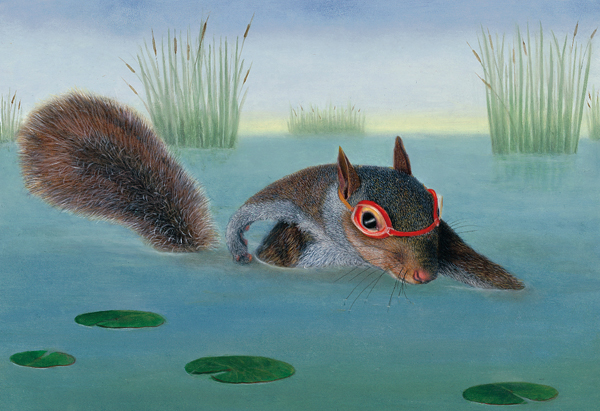How to Be Wildly Successful
If at first you don't succeed...ask yourself, Am I an otter? A squirrel? A mouse? The answer could spell the difference between things going swimmingly and squeaking to a halt. Find your own winning style.

Illustration by Kam Mak
It was a problem I'd never anticipated: My brainy daughter was having trouble in school. Katie began teaching herself to read at 15 months and tested at a "post–high school" level in almost every subject by fourth grade. Yet her middle-school grades were dropping like a lead balloon, and her morale along with them. I cared more about the morale than the grades. I knew Katie was quickly losing something educational psychologists call her sense of self-efficacy—her belief that she could succeed at specific tasks and life in general. People who lack this trait tend to stop trying because they expect to fail. Then, of course, they do fail, feel even worse, shut down even more, and carry on to catastrophe.
I couldn't understand what put Katie on this slippery slope. True, some people seem genetically inclined to believe in themselves—or not—but experience powerfully influences our sense of self-efficacy. I knew Katie had been confident as a preschooler, but her current trouble at school was destroying her optimism. I tried to help in every way I could. I created homework-checking systems, communicated with teachers like bosom buddies, doled out penalties and rewards. Mostly, though, I just kept cheering Katie on. I was sure that if she would stop hesitating, believe in herself, and just throw herself into the task at hand, she'd get past the problem.
Boy, was I ever wrong.
It took years of confidence-battering struggle—for both Katie and me—before I finally got the information I needed. It came from a no-nonsense bundle of kindly energy named Kathy Kolbe, a specialist on the instinctive patterns that shape human action. Kathy's father pioneered many standardized intelligence tests, but Kathy was born with severe dyslexia, which meant that this obviously bright little girl didn't learn in a typical way. She grew up determined to understand and defend the different ways in which people go about solving problems.
The day Katie and I met her, Kathy was wearing a T-shirt that said "do nothing when nothing works," a motto that typifies her approach. On her desk were the results from the tests (the Kolbe A and Y Indexes) that my daughter and I had just taken to evaluate our personal "conative styles," or typical action patterns.
"Well," said Kathy, glancing at a bar graph, "I see you both listen better when you're drawing."
Katie and I stared at each other, astonished. Bull's-eye.
"And you've both had a zillion teachers tell you to stop drawing. They said you could do only one thing at a time, but that's not true for you two, is it? You have a hard time focusing if there's nothing to occupy your eyes and hands."
Unexpectedly, I found myself tearing up with gratitude. I'd never realized how frustrated I'd been by the very situation Kathy was describing. Katie sat up a little straighter in her chair.
"But," Kathy went on, "Martha, you go about problem-solving in a different way from Katie. There are four basic action modes, and you're what I call a Quick Start. When you want to learn, you just jump in and start messing around."
I couldn't understand what put Katie on this slippery slope. True, some people seem genetically inclined to believe in themselves—or not—but experience powerfully influences our sense of self-efficacy. I knew Katie had been confident as a preschooler, but her current trouble at school was destroying her optimism. I tried to help in every way I could. I created homework-checking systems, communicated with teachers like bosom buddies, doled out penalties and rewards. Mostly, though, I just kept cheering Katie on. I was sure that if she would stop hesitating, believe in herself, and just throw herself into the task at hand, she'd get past the problem.
Boy, was I ever wrong.
It took years of confidence-battering struggle—for both Katie and me—before I finally got the information I needed. It came from a no-nonsense bundle of kindly energy named Kathy Kolbe, a specialist on the instinctive patterns that shape human action. Kathy's father pioneered many standardized intelligence tests, but Kathy was born with severe dyslexia, which meant that this obviously bright little girl didn't learn in a typical way. She grew up determined to understand and defend the different ways in which people go about solving problems.
The day Katie and I met her, Kathy was wearing a T-shirt that said "do nothing when nothing works," a motto that typifies her approach. On her desk were the results from the tests (the Kolbe A and Y Indexes) that my daughter and I had just taken to evaluate our personal "conative styles," or typical action patterns.
"Well," said Kathy, glancing at a bar graph, "I see you both listen better when you're drawing."
Katie and I stared at each other, astonished. Bull's-eye.
"And you've both had a zillion teachers tell you to stop drawing. They said you could do only one thing at a time, but that's not true for you two, is it? You have a hard time focusing if there's nothing to occupy your eyes and hands."
Unexpectedly, I found myself tearing up with gratitude. I'd never realized how frustrated I'd been by the very situation Kathy was describing. Katie sat up a little straighter in her chair.
"But," Kathy went on, "Martha, you go about problem-solving in a different way from Katie. There are four basic action modes, and you're what I call a Quick Start. When you want to learn, you just jump in and start messing around."



